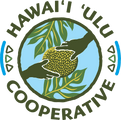Māla Kaluʻulu
Māla Kaluʻulu (MKC) is one of the nine founding members of HUC and, in some ways, provided the impetus for the initial formation of the Hawaiʻi ʻUlu Cooperative. Established in 2015 through Kamehameha Schools' Mahiʻai Matchup contest – which connects farmers to agricultural land – MKC is dedicated to restoring the ancient breadfruit agroforests that helped sustain pre-contact Hawaiʻi. The farm’s specific geographic focus is on the kaluʻulu, or ancient breadfruit belt of South Kona, which spanned nearly 10 square miles from Honaunau to Kaʻupulehu along Hawaiʻi Island’s western coast.

MKC co-founder Dr. Noa Kekuewa Lincoln, now associate professor of indigenous crops and cropping systems at the University of Hawaiʻi at Mānoa, was completing his PhD at Stanford University when the team developed its original farm plan. His doctoral research sought to define the extent and productivity of the ancient kaluʻulu. “Using multiple lines of evidence, we estimate the kaluʻulu system produced 20,000 metric tons, or about 33 million pounds, of breadfruit per year.”

Today, the farm’s mission is to "learn from the past to create a more resilient food future" for Hawaiʻi through restoring and adapting its 3.8 acre parcel to demonstrate the functionality and viability of the kaluʻulu system in the 21st century.
Over the past five years and with the help of over 300 student volunteers – including from universities across the U.S. such as Cornell and the University of Iowa, the team has removed about 80% of the invasive trees and shrubs that had overtaken the property and planted over 100 breadfruit trees representing five different varieties.
It has also installed a highly diversified subcanopy and groundcover comprised of dozens of “co-crops” including kalo (taro), ‘uala (sweet potato), ‘uhi (yam), ‘awa (kava), ‘ohiʻa ‘ai (mountain apple), ‘awapuhi (shampoo ginger), ‘olena (turmeric), pia (arrowroot), māmaki, niu (coconut), as well as non-native crops with commercial potential - such as cacao and white pineapple.

In 2017 with the help of Kamehameha Schools’ Mahi ʻai Scaleup contest, MKC expanded the scope of its operations to establish the only commercial breadfruit nursery on Hawai’i Island, helping to fuel continued growth of the island’s ‘ulu industry. In the past two years, it has distributed over 2,000 trees and currently has 6 different varieties under cultivation – two of which are readily available for purchase.

MKC’s vision for the future of this project and the property is to become a viable economic and agronomic model empowering adaptive restoration of the kalu’ulu, and driving reclamation of more and larger tracks of breadfruit agroforestry throughout South Kona.
MKC sees itself as an important node in a network of sites statewide demonstrating and educating about indigenous Hawaiian agriculture. Yet while emerging research suggests that as much as 80% of Hawaiian agriculture may have been arboriculture, very few sites are actively restoring such systems.
MKC hopes to leverage the restored system on its farm for novel research and education about traditional Hawaiian agroforestry; already the team has conducted baseline research on soil properties and function, microbial communities, and agroforestry design.

MKC’s unique hybrid structure encompassing restoration and education while at the same time pursuing economic viability as a commercial farm, is unusual in another way, as well: the farm is structured as a worker-owned cooperative. Five member-owners work the land and share in the benefits, both economic and otherwise.
Learn more about the project in the farm tour video below, created for students, and then visit the farm virtually using this interactive 360 degree tour!


1 comment
Your work is inspiring and a
“LIGHT UPON THE NATIONS OF THE WORLD”